Gurkensalat: Authentic German Cucumber Salad Recipe
Gurkensalat, translating to “cucumber salad,” has roots in traditional German cuisine. Cucumbers were cultivated in Europe as early as the Roman Empire, though they gained prominence in German culinary practices during the 16th century. German households frequently prepared Gurkensalat, often passing down family recipes through generations. This salad made its way to many tables due to its refreshing qualities and ease of preparation, especially in warmer months. The consistent use of vinegar and dill in the recipe reflects the long-standing German dietary staples, emphasizing both flavor and preservation techniques from historical practices.
Regional Variations
Different regions in Germany have their own twists on Gurkensalat. In the north, you’ll find versions enriched with cream or yogurt, giving a creamy texture and tangy taste. In contrast, southern variations often focus on a vinegar-based dressing with added sugar, delivering a sweet and sour profile. Some areas in East Germany prefer a more straightforward approach, using just cucumbers, onions, and a vinegar dressing. These distinctions in preparation methods highlight the diverse culinary landscape within Germany while maintaining the core elements that make Gurkensalat a beloved dish across the country.
Key Ingredients in Gurkensalat
Cucumbers: The Star of the Dish
Cucumbers form the base of Gurkensalat. They provide a crisp and refreshing texture. Opt for English cucumbers if you’d like a mild flavor. Slice them thinly to ensure each piece absorbs the flavors of the dressing. Use a mandoline slicer for uniform cuts if you’re after precision. This vegetable’s high water content makes the salad light and hydrating.
The Role of Dill and Onions
Dill and onions contribute significantly to the flavor profile of Gurkensalat. Fresh dill offers a subtle anise-like taste that enhances the dressing. Use finely chopped dill to scatter evenly throughout the salad. Red or white onions add a zesty sharpness. Thinly slice the onions to prevent overpowering the overall taste. Soaking them briefly in cold water before adding them to the mix can reduce their pungency if you’d prefer a milder flavor. These elements, combined with the cucumbers, create a balanced and delightful salad.
Step-by-Step Recipe for Gurkensalat
Preparing the Cucumbers
Start by selecting fresh cucumbers, as they ensure optimal flavor and texture in your Gurkensalat. Use firm cucumbers with dark green skin. Wash the cucumbers under cold water to remove dirt and chemicals. Peel the cucumbers using a vegetable peeler or knife, removing all the skin. Slice the cucumbers into thin, even rounds. This step enhances the salad’s visual appeal and ensures a uniform taste. For best results, use a mandoline slicer. After slicing, place the cucumber rounds in a colander. Sprinkle salt over them, which draws out excess moisture, and let them sit for 20 minutes. Rinse the cucumbers under cold water to remove the salt, then pat them dry with paper towels.
Mixing the Ingredients
Combine your prepared cucumber slices in a large mixing bowl. Add finely chopped onions to enhance flavor and provide a slight crunch. Measure and add vinegar, sugar, and a pinch of salt to create the dressing. Whisk these ingredients together until the sugar dissolves, then pour the dressing over the cucumbers and onions. Add fresh, finely chopped dill for an authentic German touch. Toss everything gently to ensure even coating. Refrigerate the salad for at least one hour to allow the flavors to meld. Serve chilled for the best experience.
Health Benefits of Gurkensalat
Nutritional Information
Gurkensalat offers a range of essential nutrients in every serving. Cucumbers, the main ingredient, are low in calories with only 16 calories per 100 grams. They provide a good source of vitamins K and C, crucial for blood clotting and immune health, respectively. Additionally, cucumbers are rich in antioxidants, which help combat free radicals in the body. Vinegar, a key component in Gurkensalat, has been shown to aid digestion and may help in regulating blood sugar levels. Dill enhances the nutrient profile further by adding vitamin A and trace minerals such as manganese and calcium.
| Nutrient | Value per 100g |
|---|---|
| Calories | 16 kcal |
| Vitamin K | 16.4 µg |
| Vitamin C | 2.8 mg |
| Antioxidants | – |
| Fiber | 0.5 g |
Diet-Friendly Features
Gurkensalat fits seamlessly into various dietary needs. It’s inherently low in carbohydrates, making it suitable for ketogenic diets. Diabetics benefit from its low glycemic index, which assists in maintaining stable blood sugar levels. This salad is also a valuable choice for those on weight management plans, given its high water content and low-calorie count. Vegetarians and vegans can enjoy Gurkensalat without modification, as its ingredients are entirely plant-based. The presence of vinegar adds an acidity that enhances satiety, potentially aiding in portion control.
Pairing Gurkensalat with Other Dishes
Traditional German Pairings
Serve Gurkensalat alongside classic German dishes to enhance your meal. Bratwurst pairs well with this refreshing salad, as the crisp cucumbers balance the rich, savory sausage. Another traditional combination is Wiener Schnitzel; the acidity of Gurkensalat cuts through the fried, breaded meat, creating a perfect harmony. Kartoffelsalat (German Potato Salad) complements Gurkensalat too, offering a delightful mix of textures when served together. Try pairing it with Sauerbraten, a pot roast characterized by its tangy marinade, to highlight Gurkensalat’s crisp and refreshing qualities.
International Cuisine Combinations
Experiment with Gurkensalat in international cuisine for a diverse dining experience. Include it in a Mediterranean platter with falafel, hummus, and pita, where its freshness contrasts nicely with the rich and creamy elements. Use it as a side for grilled meats in Middle Eastern cuisine, like kebabs, to add a crunchy, cool component. In Asian cuisine, serve it with sushi or tempura; Gurkensalat’s lightness offers a palate-cleansing effect. Consider pairing it with Mexican dishes like tacos or enchiladas, where it provides a cool and zesty juxtaposition to spicier flavors.
Conclusion
Gurkensalat is more than just a cucumber salad; it’s a culinary gem with a rich history and diverse applications. Its refreshing taste, combined with significant health benefits, makes it an excellent addition to any meal. Whether you’re looking to enhance traditional German dishes or add a fresh twist to international cuisine, Gurkensalat offers versatility and flavor. Embrace this delightful salad and elevate your dining experience with its unique combination of ingredients and nutritional advantages.






